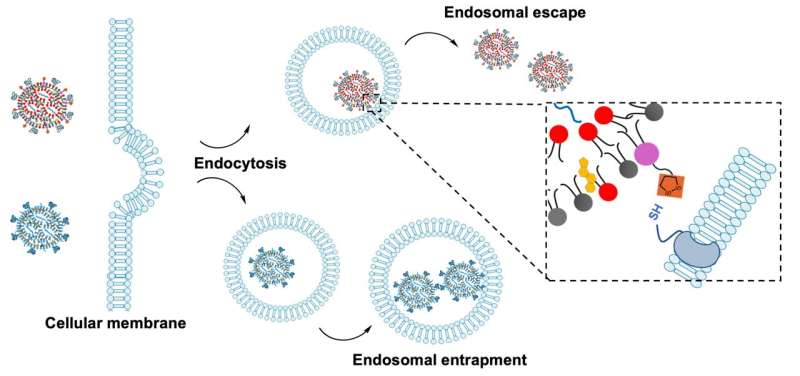Researchers at Nagoya University in Japan have developed a lipid nanoparticle that delivers mRNA to cells five times more effectively. By attaching a sulfur-containing ring structure—a cyclic disulfide—to lipid molecules, they found that significantly more mRNA can escape from cell components that normally destroy genetic material. When tested as a cancer vaccine in mice, the new delivery system stopped tumor growth.
The study, published in the journal RSC Medicinal Chemistry, demonstrates the first successful use of cyclic disulfide-containing lipids to improve mRNA delivery in animals and suppress tumor growth.
Escaping the endosomes
During formulation, when mRNA and lipids are mixed under specific conditions, the lipids spontaneously arrange themselves into spherical structures that encapsulate and protect the mRNA inside.
When mRNA enters cells, more than 95% gets trapped by small compartments called endosomes and is eventually broken down before it can work. Endosomes are intracellular organelles that control the sorting and degradation of substances entering cells.
The new disulfide-based delivery system helps mRNA break out of these organelles and reach its target. This allows better delivery of genetic instructions to cells to produce antigens, triggering the immune system to produce antibodies and activate immune cells.
“The modified lipids showed significant improvements in mRNA delivery. Some formulations achieved up to 6-fold better efficiency in cell culture experiments and 5-fold improvement in mice compared to standard methods,” Dr. Seigo Kimura, lead author and researcher from the Integrated Research Consortium on Chemical Sciences (IRCCS) at Nagoya University, explained.
“While disulfide chemistry has been used to improve drug delivery for years, it has only worked in laboratory cell cultures and not in living organisms. This study is the first to demonstrate that disulfide chemistry can improve mRNA delivery in vivo and work effectively as a cancer vaccine in mice.”

Chemically engineering better delivery of mRNA
The modified molecules were tested using two proven lipid formulations: MC3, a standard formulation used in nucleic acid delivery, and SM102, a formulation used in a COVID-19 vaccine. They created enhanced versions of each formulation by adding the cyclic disulfide molecules and tested them first on human cells in the lab to see how well they delivered mRNA. The best-performing formulations were then tested in mice to check delivery effectiveness and cancer vaccine responses.
The researchers compared the modified particles against the standard formulations, tracking where they went inside cells, how well they escaped cellular traps, immune responses, and tumor growth. Both versions significantly outperformed their standard counterparts, suggesting that these molecules can improve existing delivery systems.
The most technically challenging part of the research was designing the molecular structure to add disulfide lipids into the particles, as these particles consist of four different types of lipid molecules in a complex system. About 20% of the lipid molecules in each nanoparticle were new cyclic disulfide lipids.
Cancer ranks as the second leading global cause of death, but an effective vaccine has not been developed yet. Because cancer cells originate from the body’s own cells, it is hard for the immune system to recognize them as dangerous. Consequently, vaccines face many challenges such as delivery efficiency, immune evasion, tumor suppression, and biological complexity.
“While this research shows promise in overcoming delivery limitations, it is still in its early stages and we need to conduct further testing in different delivery methods and safety studies,” Dr. Kimura highlighted.
More information:
Seigo Kimura et al, In vivo demonstration of enhanced mRNA delivery by cyclic disulfide-containing lipid nanoparticles for facilitating endosomal escape, RSC Medicinal Chemistry (2025). DOI: 10.1039/D5MD00084J
Nagoya University
Citation:
New cyclic disulfide lipids help stop cancer growth in mice (2025, July 28)
retrieved 29 July 2025
from https://medicalxpress.com/news/2025-07-cyclic-disulfide-lipids-cancer-growth.html
This document is subject to copyright. Apart from any fair dealing for the purpose of private study or research, no
part may be reproduced without the written permission. The content is provided for information purposes only.


